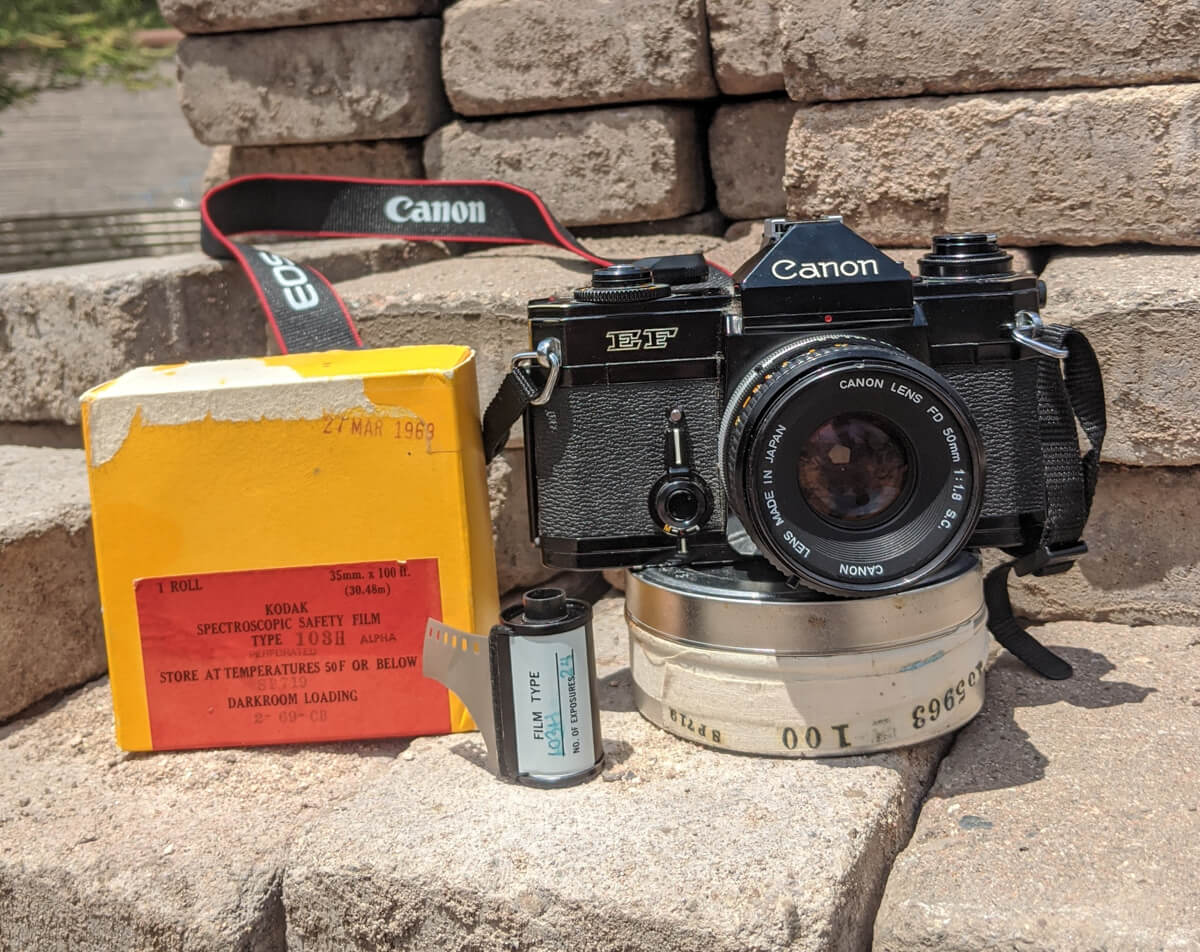I received a 100-foot roll of fifty-one year old Type 103 H Kodak Spectrographic Film in June 2020. Like the 1978 Canon EF with stock 50mm lens I used to shoot it, it was a gift. Having a reputation for loving old cameras and weird film means that sometimes people you barely know will send you the odd spool or SLR found in their basement while quarantine cleaning. Not a bad thing.
While instructions for the Canon could be picked up online, not much about the Type 103 H film can be found, beyond that the “H” in 103 H stands for “Hydrogen”. This means that the film was sensitized to the deep red light at 656 nm, the brightest hydrogen line in the visible spectrum. The March 27, 1969, the date stamp on the box, shows that it was received the same day as the Mariner 7 launch (or Mariah Carey’s birthday, depending on your taste). Normally, fifty year old film would mean that I should pull the film five stops to make up for loss of sensitivity. But, without the initial sensitivity, I’m left to my stock of chemicals and experimentation to properly expose and develop it. Puzzles like this are a welcome distraction during these days when Arizona is at peak COVID-19 contagion, so I dove right in, grabbing images from around my home in Tucson.

First discovery: fast fixers and warm Arizona rinse water turn the emulsion gooey. Many images from my first roll were literally smeared off the substrate, or were distorted from the heat, looking more like 1869 than 1969. In the end an ISO of 50 using diffuse/cloudy light seemed to work best (no anti-halation layer means direct sunlight gives lightly colored objects a halo). Similarly, experimentation showed the best developing results came from Rodinal over HC-110 (really muddy) and Dektol (huge grain). The best developing times were shorter than most films, but I opted to offset that by lowering the temperature 7-10°C to avoid things going to sludge. Acid-based stopper and fixers round out the regimen.
As expected, the film is red sensitive – both a yellow and red pepper comes across as almost exactly the same shade of light grey. Green grapes have a dirtier shade, indicating lower sensitivity for that color. Still, shots of ever-patient neighborhood cacti photograph well, despite the occasional blemish or fog that I fancy comes from decades of stray Cold War radiation exposure.





This film was designed for science, not for a punchy artistic statement, so it can be forgiven for being a little flat and grainy. Plus there are other parts of the spectrum that need to be explored, putting me in the market for an infrared filter. With 92 feet of film to go, there are other puzzles that are to be solved, and once the world opens up, many more things to see through this unique film.
~ Paul
Submit your 5 Frames… today
Get your own 5 Frames featured by submitting your article using this form or by sending an email via the contact link at the top of the page.
Share your knowledge, story or project
The transfer of knowledge across the film photography community is the heart of EMULSIVE. You can add your support by contributing your thoughts, work, experiences and ideas to inspire the hundreds of thousands of people who read these pages each month. Check out the submission guide here.
If you like what you’re reading you can also help this passion project by heading over to the EMULSIVE Patreon page and contributing as little as a dollar a month. There’s also print and apparel over at Society 6, currently showcasing over two dozen t-shirt designs and over a dozen unique photographs available for purchase.








2 responses to “5 Frames… Of Type 103 H-Alpha Kodak Spectroscopic Film with a Canon EF + Canon FD 50mm f1.8 SC (35mm Format / EI 100)”
For a first test, these are excellent, well done. I really like the cacti photograph. The EF camera was a gift? This is a serious machine made to top-grade standards. For 35mm film use, this should serve you well for decades.
Pretty impressive. Good luck with the rest!